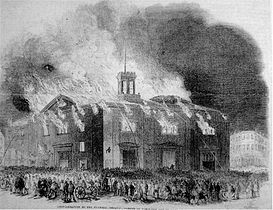| Year | Play | Author |
|---|
| 1837 | Carpenter of Rouen! or The confrerie of St. Bartholomew | J.S. Jones [8] |
| 1838 | 3 degrees of Banking | J.S. Jones [8] |
| 1838 | Surgeon of Paris; or, The Mask of the Huguenots | Joseph Stevens Jones |
| 1838 | Hamlet [9] | |
| 1838 | Valet de Sham | Charles Selby [8] |
| 1839 | | |
| 1839 | Moll Pitcher; or, The Fortune Teller of Lynn | |
| 1839 | Solon Shingle; or, The People's Lawyer | Joseph Stevens Jones |
| 1842 | Ivanhoe [10] | |
| 1844 | Jack Sheppard | J.B. Buckstone [8] |
| 1844 | Nervous Man | William Bayle Bernard [8] |
| 1846 | Wizard of the wave! or—The ship of the avenger! | John Thomas Haines [8] |
| 1848 | | |
| 1848 | | Jonathan Harrington (ventriloquist) [11] |
| 1847 | Witchcraft! or the Martyrs of Salem [12] | Cornelius Mathews [13] |
| 1849 | Serpent of the Nile [8] | |
| 1849 | Ben the Boatswain | Thomas Egerton Wilks [14] |
| 1849 | Mazeppa or The wild horse of Tartary [8] | |
| 1849 | Ivanhoe! or—The knights templars [8] | |
| 1851 | Stranger or,--Misanthropy & repentance | Kotzebue [8] |
| 1851 | Honey moon or, how to rule a wife | John Tobin [8] |
| 1852 | Philip Augustus of France | J. Westland Marston [15] |
| 1852 | I've Swallowed a Policeman [8] | |
| 1852 | Heir-at-Law | |
| 1853 | Pet of the petticoats | John Baldwin Buckstone [8] |
| 1853 | Fortunio and his seven gifted servants | Madame d'Aulnoy/James Planché [8] |
| 1853 | Madelaine, The Belle of the Faubourg | Virginia Cunningham [16] [17] |
| 1853 | Faint heart never won fair lady | J.R. Planche [8] |
| 1853 | Wept of the Wish-ton-Wish | Wm. Bayle Bernard [8] |
| 1853 | Tower of Nesle! or The chamber of death | George Almar, adapted from Dumas and Gaillardet's La tour de Nesle. [8] |
| 1853 | Six degrees of crime | Frederic Stanhope Hill [8] [18] [19] |
| 1853 | Gale Breezely! or, The tale of a tar | J.B. Johnstone [8] [20] |
| 1853 | Ernest Maltravers: or, The robber father and maniac daughter | Bulwer-Lytton [8] |
| 1853 | Lady of Lyons | Bulwer [8] |
| 1854 | Egyptian Prince, "the very popular Ethiopian farce" [8] | |
| 1854 | Othello [8] | |
| 1854 | That Good for Nothing [8] | |
| 1854 | Faustus [8] | |
| 1854 | Monte Cristo [8] | |
| 1854 | Sledge Driver | Planche [8] |
| 1854 | Much Ado About Nothing [8] | |
| 1854 | Mary Tudor or, The artisan and the Jew [8] | |
| 1854 | Fallen angel or Faust and Margaret | Dion Boucicault [8] |
| 1854 | Devil's in it [8] | |
| 1854 | Invisible prince! or, The island of tranquil delights | Planche [8] |
| 1856 | | Cushing's New York Circus [21] |
| 1858 | Three fast men Or, The female Robinson Crusoes [8] | |
| 1858 | Linda, the Cigar Girl [8] | |
| 1858 | O'Flanagan and the fairies [8] | |
| 1858 | Buck bison: or, Baby Blanche, the child of the prairie [8] | |
| 1858 | Woman's love Or, The secrets of the heart [8] | |
| 1858 | Farmer's son Or, The golden axe [8] | |
| 1859 | Inez, the poisoner | Frederic S. Hill [8] |
| 1859 | Flowers of the Forest, A gipsey story | J.B. Buckstone [8] |
| 1859 | Cross of gold, or Theresa's vow [8] | |
| 1859 | Three guardsmen or, The seige [ sic?] of Rochelle [8] | |
| 1859 | Magic pills! Or, The conjuror's gift, "a grand Christmas pantomime" [8] | |






